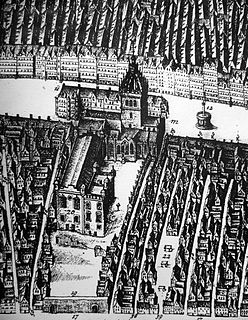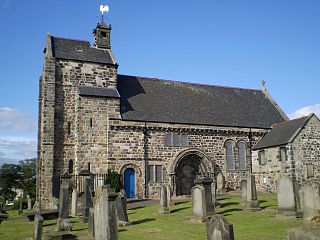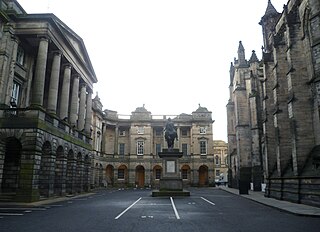 W
WThe Parliament of Scotland was the legislature of the Kingdom of Scotland. The parliament, like other such institutions, evolved during the Middle Ages from the king's council of bishops and earls. It is first identifiable as a parliament in 1235, during the reign of Alexander II, when it was described as a "colloquium" and already possessed a political and judicial role. By the early 14th century, the attendance of knights and freeholders had become important, and from 1326 commissioners from the burghs attended. Consisting of the "three estates" of clergy, nobility and the burghs sitting in a single chamber, the parliament gave consent for the raising of taxation and played an important role in the administration of justice, foreign policy, war, and all manner of other legislation. Parliamentary business was also carried out by "sister" institutions, such as General Councils or Convention of Estates. These could carry out much business also dealt with by parliament – taxation, legislation and policy-making – but lacked the ultimate authority of a full parliament.
 W
WGeneral elections were held in Scotland in 1702 to return members to serve in the Estates of Parliament. The new government would be a minority Court party administration, led by the Duke of Queensberry as Lord High Commissioner. The election took place amidst the War of the Spanish Succession, and one of Queensberry's key main priorities was to secure Scottish funding for the war. The new parliament assembled in Edinburgh on 6 May 1703.
 W
WA commissioner was a legislator appointed or elected to represent a royal burgh or shire in the pre-Union Scottish Parliament and the associated Convention of the Estates. Member of Parliament (MP) and Deputy are equivalent terms in other countries.
 W
WThe 1689 Convention of Estates sat between 16 March 1689 and 5 June 1689 to determine the settlement of the Scottish throne, following the deposition of James VII in the 1688 Glorious Revolution. The Convention of the Estates of Scotland was a sister-institution to Parliament, comprising the three estates of bishops, barons and representatives of the Burghs. Historically, it had been summoned by the king of Scots for the limited purpose of raising taxes, and could not pass other legislation. Unlike the English Convention Parliament of 1689, the 1689 Scottish Convention was also a contest for control of the Church of Scotland or kirk.
 W
WKirkliston is a small town and parish to the west of Edinburgh, Scotland, historically within the county of West Lothian. It lies on high ground immediately north of a northward loop of the Almond, on the old road between Edinburgh and Linlithgow, having a crossroads with the road from Newbridge to Queensferry and beyond to Fife. The B800 is variously named Path Brae, High Street, Station Road, and Queensferry Road as it passes through the town. The B9080 is named Main Street and Stirling Road as it passes through.
 W
WThe Old Tolbooth was an important municipal building in the city of Edinburgh, Scotland for more than 400 years. The medieval structure, which was located at the northwest corner of St Giles' Cathedral and was attached to the west end of the Luckenbooths on the High Street in the Old Town, was first established in the 14th century by royal charter. Over the years it served a variety of purposes such as housing the Burgh Council, early meetings of the Parliament of Scotland and the Court of Session. The Tolbooth was also the burgh's main jail where, in addition to incarceration, physical punishment and torture were routinely conducted. From 1785 public executions were carried out. In 1817 the buildings, which had been rebuilt and renovated several times, were demolished.
 W
WParliament House in Edinburgh, Scotland is a complex of several buildings housing the Supreme Courts of Scotland. The original building was home to the pre-Union Parliament of Scotland from 1639 to 1707. It is located in the Old Town, just off the High Street section of the Royal Mile, beside St Giles' Cathedral. It is a Grade A listed building.
 W
WA Satire of the Three Estates, is a satirical morality play in Middle Scots, written by makar Sir David Lyndsay. The complete play was first performed outside in the playing field at Cupar, Fife in June 1552 during the Midsummer holiday, where the action took place under Castle Hill. It was subsequently performed in Edinburgh, also outdoors, in 1554. The full text was first printed in 1602 and extracts were copied into the Bannatyne Manuscript. The Satire is an attack on the Three Estates represented in the Parliament of Scotland – the clergy, lords and burgh representatives, symbolised by the characters Spiritualitie, Temporalitie and Merchant. The clergy come in for the strongest criticism. The work portrays the social tensions present at this pivotal moment in Scottish history.
 W
WScotland and the Thirty Years' War deals with the complicated involvement of the kingdom of Scotland in the Thirty Years' War of 1618–1648. Scotland and Scots were heavily entangled in both the diplomatic and military events centred on the Holy Roman Empire. There were a number of reasons for this participation.